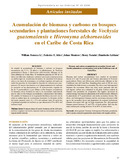Mostrar el registro sencillo del ítem
Acumulación de biomasa y carbono en bosques secundarios y plantaciones forestales de Vochysia guatemalensis e Hieronyma alchorneoides en el Caribe de Costa Rica
| dc.contributor.author | Fonseca G, William | es_Es |
| dc.contributor.author | Alice, Federico E. | es_Es |
| dc.contributor.author | Montero, Johan | es_Es |
| dc.contributor.author | Toruño, Henry | es_Es |
| dc.contributor.author | Leblanc, Humberto | es_Es |
| dc.contributor.other | CATIE - Centro Agronómico Tropical de Investigación y Enseñanza | |
| dc.date.accessioned | 2015-03-19T20:53:26Z | |
| dc.date.available | 2015-03-19T20:53:26Z | |
| dc.date.issued | 2008 | |
| dc.identifier | 472577 | es_ES |
| dc.identifier.issn | 1022-7482 | es_ES |
| dc.identifier.uri | https://repositorio.catie.ac.cr/handle/11554/5742 | |
| dc.description | 8 páginas: 1 figura, 3 tablas. | es_ES |
| dc.description | Incluye 29 referencias bibliográficas en las páginas 63-64 | |
| dc.description.abstract | Se estudió la acumulación de biomasa y carbono en bosques secundarios (de 5, 8 y 18 años) y en plantaciones de Vochysia guatemalensis Donn. e Hieronyma alchorneoides Allemao en la zona atlántica de Costa Rica. Se instalaron parcelas de 500 m2 en sitios con diferente edad para construir una seudo-cronosecuencia en ambos tipos de ecosistemas forestales. Se cuantificó la biomasa aérea y de raíces, la necromasa y el carbono orgánico del suelo en todas las parcelas. Se determinó la fracción de carbono por componente. El mayor incremento en el almacenamiento de carbono se encontró en las plantaciones de H. alchorneoides, seguido de las de V. guatemalensis y, por último, en los bosques secundarios. La biomasa aérea, biomasa de raíces y la necromasa aumentaron con la edad en los bosques secundarios y plantaciones forestales. En cambio, la biomasa de la vegetación herbácea decreció con la edad en ambos tipos de ecosistemas forestales. La biomasa arriba del suelo contiene entre 11 y 17 por ciento del carbono total. El suelo fue el principal depósito de carbono, ya que almacenó el 76 a 86 por ciento del carbono total. Biomass and carbon accumulation were studied in secondary forests (5, 8 and 18 years old) and forestry plantations of Vochysia guatemalensis Donn. and Hieronyma alchorneoidesAllem{hooka}o in the Caribbean zone of Costa Rica. Sampling plots, each of 500 m2, were established in both forestry ecosystems. The above and belowground biomass, the necromass (litter and dead wood material) and the soil organic carbon were estimated in all plots. Carbon content in biomass was quantified by component. The highest increment in carbon storage was found in plantations of H. alchorneoides, followed by plantations of V. guatemalensis and, lastly, secondary forests. The above and belowground biomass and the necromass increased with age in the secondary forest and plantations. In contrast, herbaceous biomass decreased with age in both ecosystems. The aboveground biomass stored between 11 and 17 percent of total carbon. Soil was the main carbon pool, storing between 76 an 86 percent of total carbon. | es_ES |
| dc.format.mimetype | ||
| dc.language.iso | es | es_ES |
| dc.publisher | CATIE, Turrialba (Costa Rica) | es_ES |
| dc.relation.ispartof | Agroforestería en las Américas, número 46 (2008) | |
| dc.rights | openAccess | |
| dc.rights.uri | https://creativecommons.org/licenses/by-nc-nd/4.0/ | |
| dc.subject | ARBOLES | es_ES |
| dc.subject | PLANTACION FORESTAL | es_ES |
| dc.subject | BOSQUE SECUNDARIO | es_ES |
| dc.subject | REGENERACION NATURAL | es_ES |
| dc.subject | CARBONO | es_ES |
| dc.subject | BIOMASA | es_ES |
| dc.subject | ALMACENAMIENTO | es_ES |
| dc.subject | CARIBE | es_ES |
| dc.subject | REFORESTACION | es_ES |
| dc.subject | CAMBIO CLIMATICO | es_ES |
| dc.subject | COSTA RICA | es_ES |
| dc.subject.other | Sede Central | |
| dc.title | Acumulación de biomasa y carbono en bosques secundarios y plantaciones forestales de Vochysia guatemalensis e Hieronyma alchorneoides en el Caribe de Costa Rica | es_ES |
| dc.title.alternative | Biomass and carbon acumulation in secondary forests and forestry plantations as restoration tools in the Caribbean zone of Costa Rica | es_ES |
| dc.type | Artículo | es_ES |
| dc.journal.issueNumber | 46 | |
| dc.journal.pages | 57-64 |



